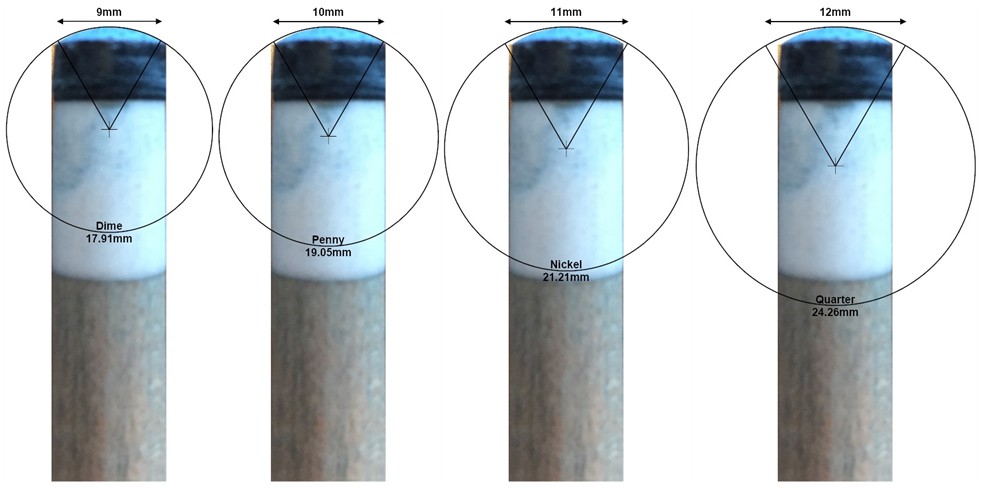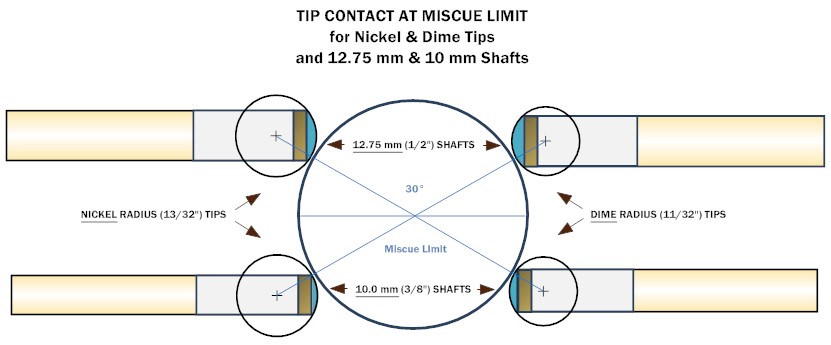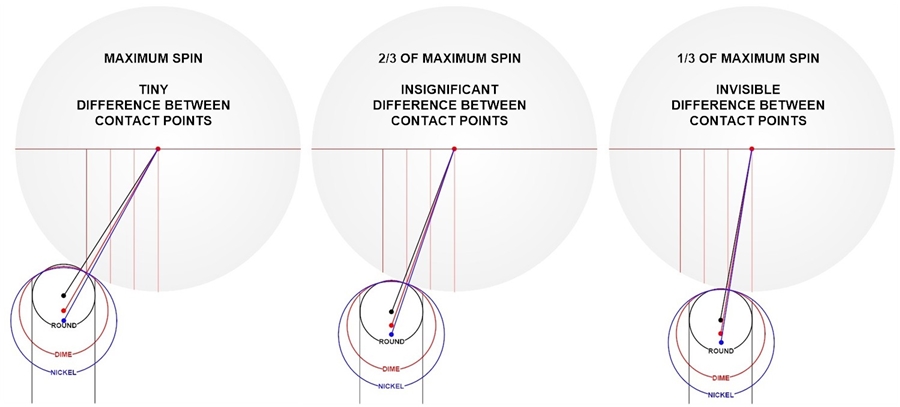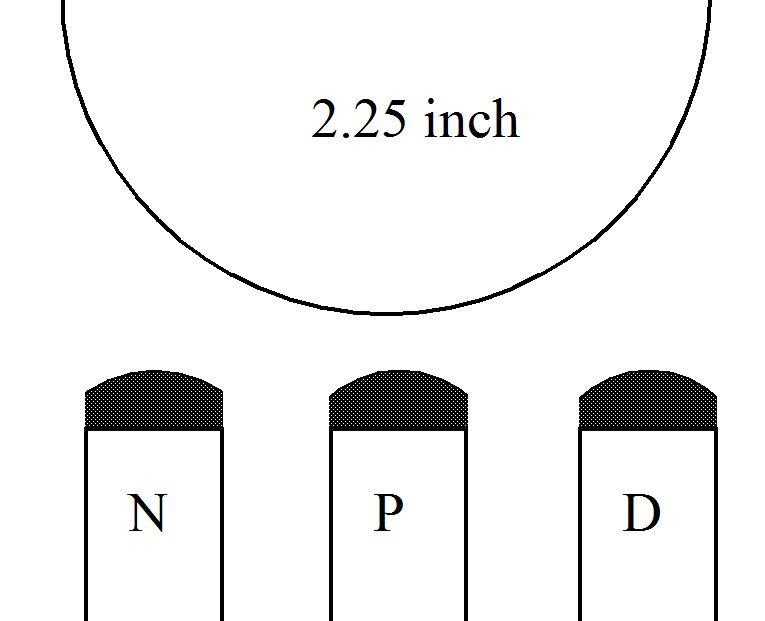Does the tip and shaft size and shape make a difference?
For applying spin, a smaller-diameter shaft and rounder tip (approximately “dime” radius) are generally recommended. Here are some possible reasons:
- The rounder shape allows for a more uniform contact area as the tip offset is increased. If you have The Illustrated Principles of Pool and Billiards, this is illustrated in Figure 2.2 on pg. 18. This could help make miscues less likely at large tip offsets. Also, see the first quote from Patrick Johnson below.
- A smaller-diameter shaft will typically have less endmass and squirt (especially if it is solid). There are possible advantages and disadvantages with a lower-squirt shaft. Some people think a smaller-diameter LD shaft allows one to put more spin on the CB, but this really isn’t the case (see getting more spin with an LD shaft).
- A smaller-diameter shaft might make it easier for some people to visualize and pinpoint the desired tip contact point on the cue ball.
- With large tip-offset draw shots, you get more table clearance (see “Draw Shot Primer – Part VII: tips of english” – BD, July, 2006 for illustrations) with a smaller-diameter shaft and rounder tip. If the diameter is too large, maximum draw might not be possible, and the tip is more likely to bounce off the table after the hit, which can cause a secondary hit and tip rub that can take away some of the backspin and maybe even scoop the ball up.
- When shooting at a CB frozen to a cushion or shooting over a ball, a smaller-diameter tip allows a good hit with the cue more level, making the shot easier.
- For shots with spin, the impact is more centralized to the core of the cue for a rounder tip. This might result in a better “feel” for some people with firm shots. Also, the efficiency of the hit might be slightly better since there will be slightly less cue vibration with the slightly-less offset from the cue’s center. Also, it has been suggested by Predator that a centralized hit helps reduce squirt. It certainly is true that if you remove more material by rounding the tip down to a dime, you might reduce endmass and squirt. Also, there might be less sideways tip and shaft flex with a more centralized hit, which could have an effect (see what causes squirt for more info).
- A smaller diameter shaft (especially maple) is more whippy and better for fouetté shots.
However, per the quotes from Patrick Johnson and Bob Jewett below, there really isn’t much difference between a “dime” shape and a “nickel” shape.
One advantage of a flatter tip is that a center-ball hit, with some tip placement inaccuracy, will generally have less unintentional english (and unexpected squirt/swerve/throw). In other words, a larger, flatter tip is more “forgiving” with misalignment errors for near-center-ball hits. It may also be easier to control small amounts of sidespin since more cue offset is required to create more sidespin, as compared to a rounder tip. With stroking errors, where the cue is pivoted relative to the bridge, a flatter tip will result in less sidespin; however, the CB will head in the direction of the pivoted cue (minus the small amount of squirt corresponding to the small amount of sidespin). Therefore, the potential benefits of automatic stroking-error correction due to back-hand english (BHE) effects won’t work as well with a flatter tip (unless the bridge length is very long).
As shown in the diagram below, for a given cue tip position, a rounder tip will result in more spin since the tip contact point is farther from CB center with a rounder tip. However, for a given tip contact point position, all tip shapes will result in the same amount of spin. You just need to visualize and focus on the tip contact point, and not the tip position, when applying spin. This is especially important for people who use “tips” of english, where tips of different sizes and shapes will result in different amounts of spin for a given number of “tips.” For more info, see “Squirt – Part VI: tip shape” (BD, January, 2008).

Another concern related to shaft diameter is bridge comfort. With a closed bridge, some shaft sizes and tapers will be more comfortable than others to different individuals. This is less of a concern with an open bridge.
Tip shape can also affect the results of squirt-testing machines that position the shaft and CB the same with each test. If the tip shape is different from one shaft to the next, the effective tip offset will be different, creating a slightly different amount of squirt, with everything else being equal. This could have an adverse effect on squirt-testing results. In comparing shafts, identical tips should be used. Each shaft should be tested with the same tip size, shape, height, hardness, and weight.
Tip height can also have an effect on the amount of squirt (CB deflection) a shaft creates, especially if there is a heavy ferrule (e.g., brass) on the shaft. Pushing the heavy ferrule weight back from the CB (by using a taller tip, which is much less dense than the ferrule) even a little can make a significant difference on the shaft endmass and resulting squirt. Diagram 4 in “Squirt – Part VII: cue test machine results” (BD, February, 2008) documents experiments done to show the effects of mass at different distances from the CB.
from Patrick Johnson (from AZB post):
As tip sizes trend smaller I’m sure people are finding that smaller tips work better if they’re a little more “rounded”. Here’s why.
You need an arc on your tip that spans a little more than 60 degrees (1/6 of a whole circle) in order to use maximum spin without hitting right on the tip’s edge. Every tip width doesn’t do that with every tip curvature.
Here’s a pic of my own (embarrassingly dirty) 10mm tip compared to the curvatures of different size US coins (with 60 degree arcs marked on each). The only coin that’s “round enough” to encompass 60 degrees in less than 10mm is a dime (far left in the pic). Any flatter than that and I’m hitting on the tip’s edge too soon.
The dimensions above each tip are the minimum tip widths necessary with each curvature in order to use maximum spin without hitting on the edge of the tip. For example, a nickel shape works best with a tip more than 11mm wide – a quarter shape (pretty flat), more than 12mm.

from Patrick Johnson (from AZB post):

(The diagram above) shows four tips touching the cue ball at 30° offset from center (about halfway from center to edge), which is about where the miscue limit is no matter what the size or shape of your tip.
There are two shaft diameters shown: top = 12.75mm; bottom = 10mm. There are two tip shapes shown: left = nickel radius; right = dime radius.
As you can see, the larger diameter shaft (at top) contacts the cue ball farther from its edge at the miscue limit, and there’s room at the edge of the tip to spare with either tip shape. This is because a 60° arc (30° in each direction) on a nickel or dime radius is smaller than 12.75mm wide.
The smaller diameter shaft (at bottom) still has a small amount of room at the edge of the tip with the dime shape, but is right on the edge with the nickel shape. This is because a 60° arc (30° in each direction) on a nickel radius is just about 10mm wide and on a dime radius it’s just a little less than 10mm wide.
Conclusions:
– Nickel or dime radius only makes a difference on very small diameter tips.
– On very small tips it’s better to have a dime radius than a nickel radius.
from Patrick Johnson (in AZB post):
To avoid hitting on a tip’s edge, it should be shaped to a curvature radius less than its width.
For example:
– a 13mm tip needs a curvature with a radius less than 13mm – a quarter
– a 12mm tip needs a curvature with a radius less than 12mm – a nickel
– a 10mm tip like mine (similar to a snooker tip) needs a dime radius
from Patrick Johnson (in AZB post):
The scale drawing below shows an overhead view of three cues hitting three cue balls at different offsets – cue moved 1/4″, 1/2″ and 3/4″ to the left. Just for fun, it also compares where nickel and dime shaped tips contact the CB at those offsets, assuming the cue’s centerline is offset the same amount.
I notice two interesting things:
1. These three very common tip offsets – often called 1, 2 & 3 (or 1/2, 1 and 1 1/2) “tips” – produce almost exactly 1/3, 2/3 and 3/3 of maximum sidespin (the red lines on the CB), which correspond to 1, 2 and 3 diamonds of cross-table angle change. I just find this correspondence remarkably convenient.
2. The difference in contact points for nickel and dime shaped tips (shown by the circles at the cues’ tips and the lines connecting their centers with the CB’s center) is almost nonexistent: 1/128″ at 1/3 max sidespin, 1/64″ at 2/3 max sidespin and less than 1/32″ at maximum sidespin (true for nickel and dime tips of any width). So how true is it really that a dime shaped tip can produce noticeably more spin for the same tip offset?

from Patrick Johnson (in AZB post):
Here’s a scale drawing showing the relative differences in the normal range of sizes – 11 to 13 mm (+ a 10 mm snooker tip for comparison). [The difference is smaller than some people might think.]

from Bob Jewett (in AZB post):
Here is a scale drawing of the three curvatures with a cue ball for comparison (N = nickel, P = penny, D = dime).

from RSB FAQ:
The spin/speed ratio on the cue ball depends primarily on the actual tip-ball contact point. With a rounded tip there is a smooth relation between the shaft displacement and the resulting spin/speed ratio. But with a flat tip, you can displace the shaft up to 1/2 of the tip diameter before the actual contact point on the cue ball changes. Then with a little more shaft displacement there is some sidespin imparted, and then the tip starts to miscue because you are hitting right on the square edge of the tip.
You seldom want to hit the ball right in the middle, you don’t want to miscue, and you want to have precise control of the spin. Therefore, a rounded tip is better than a flat tip. You shape the tip with a tip scuffer, a file, a piece of sandpaper, and other similar abrasive tools. Most players like their tips rounded with the radius of either a nickel or a dime; a coin can be held next to the tip for reference.
Dr. Dave keeps this site commercial free, with no ads. If you appreciate the free resources, please consider making a one-time or monthly donation to show your support:
